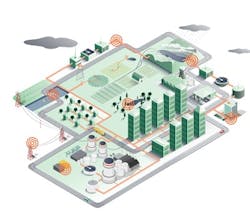About the author: David Dolphin is director of the water and wastewater sector for Ayyeka. Dolphin can be reached at [email protected] or 857.206.5005.
With the Internet of Things (IoT) comes the ability to create smart networks that can optimize the management of everything from sewers to offshore infrastructure like oil wells.
Smart networks differ dramatically from existing telemetric solutions that have allowed for limited-scale remote monitoring to be carried out for decades. Modern IoT solutions leverage advanced low-power, low-bandwidth communication networks to relay information directly from the field to network administrators at a greater scale than has been possible before.
The information obtained from smart networks can be used in a multitude of ways, such as through internal analysis programs or by direct integrations with supervisory control and data acquisition (SCADA) systems used to oversee critical infrastructure networks.
Below is a step-by-step guide that will help utilities that want to deploy smart networks.
Network Planning
Plan which elements of the infrastructure will be monitored and determine which parameters real-time knowledge is required to maximize network performance. A water utility with significant leakage problems, for example, may be interested in district metered area sensing to reduce non-revenue water, while a wastewater plant may need to know the level of corrosive chemicals, such as hydrogen sulfide in its system.
After determining the parameters that will be monitored, source an IoT hardware provider that sells the appropriate sensors to monitor these parameters. For OEMs, this may involve hardware that can integrate with their own solutions.
Those undertaking the monitoring effort to comply with legislation, such as U.S. Environmental Protection Agency ordinances, should ensure that all equipment used, especially the sensors, meet the legislation’s requirements.
Answering questions will further guide the choice of vendor. Does the infrastructure network consist of widely dispersed assets, such as a water distribution network (involving reservoirs, pumping stations, and endpoints hundreds of kilometers apart), or is it a more centralized, within-the-perimeter system, such as an oil and gas rig?
Will some of the assets live below the surface (such as in a sewer) or far off the coast, beyond the reach of traditional cellular networks (such as on an oil rig)? LP-WAN networks, such as Sigfox and LoRa, can penetrate intervening concrete structures with relative ease and, as an unlicensed network, base stations can be set up wherever the network needs to go. GSM-based networks, by comparison, are limited to the infrastructure deployed by the network operator.
What sample rate will be sufficient to obtain the needed information? Is it variable? If so, upon which conditions does it depend? More frequent sample rates and higher bandwidth transmissions incur greater power overheads. IoT gateways with external power supplies may be more suitable in cases with these requirements.
Network Deployment
Once a remote monitoring platform is chosen, deployment of the field sensors that will comprise the smart network can begin. The complexity of the installation project will depend on the extent of the network, and whether the sensing equipment being installed will be powered by on-board or external power sources.
Data Collection
With installation complete, the process of collecting data from the smart network begins. Depending on the provider selected, the data may be traveling to a SCADA system, an online vendor’s user interface (UI), or another destination, such as a public or private cloud.
While data collection is a passive process, system maintenance is not. Much of the upkeep, such as software upgrades, can be done remotely. Most installations will require field visits periodically, although the visits can be far less frequent when a remote monitoring solution is in place.
Routine operations will include sensor calibration and maintenance tasks. Given the “smart” nature of the network, proactive and predictive maintenance methodologies can be employed, reducing labor costs when compared with sending teams to the field.
On-board power sources may have to be replaced on a fixed schedule.
Smart networks are flexible and modular. Sensors may need to be added, or reconfigured, as the needs of the use-case—and monitoring program—change over time.
Data Analysis
A flood of field data risks can create a flood of confusion if network operators do not have some computer assistance to help separate network signal from noise. Data can be analyzed in situ, on the network edge or through programs running on a traditional server infrastructure. Standard, server-side data analytics programs can run on a public or private cloud to parse information obtained from the network and assist operators by flagging potentially actionable cues for action.
Edge analytics is a fast-growing, emerging discipline in which analytics-capable processing power is placed directly on the devices themselves on the network edge. This involves analyzing data in situ, while offline, and making autonomous decisions about what information to transmit to the operations room for further analysis.
System Optimization
Once a network has been deployed and is generating real-time insights about important network parameters, it is time to leverage those insights to optimize the system’s health.
Examples of this can include wastewater operators diverting sewer flows to reserve storage capacity areas in response to water level information indicating the potential for a sewer overflow event in the near future; or a water provider reducing supply chlorination in response to live readings indicating excessive chlorine level.
With the sensor nodes installed, and the data continuously being transmitted to the selected server, the smart network information is viewable and the data is available for analysis on the network.
